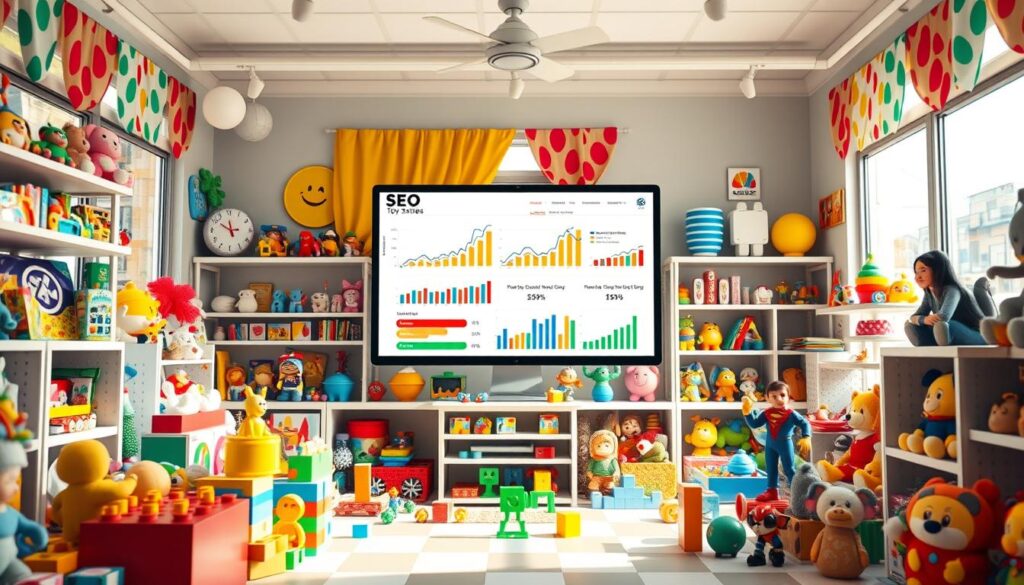Ever wondered how furniture stores pop up when you search online? That’s where SEO, or Search Engine Optimization, comes into play. It’s all about making sure your furniture store shows up in search results when folks are looking for new couches or dining sets. In today’s world, where everyone’s glued to their screens, understanding SEO can make a big difference for your store’s visibility and sales. This article will walk you through the ins and outs of SEO for furniture stores, covering everything from local strategies to keyword research.
Key Takeaways
- SEO helps furniture stores appear in search results, boosting visibility.
- Local SEO can drive more foot traffic to physical store locations.
- Keyword research is vital for targeting the right audience online.
- On-page SEO improves user experience and search ranking.
- Competitor analysis can reveal successful strategies to adopt.
Understanding SEO for Furniture Stores
Defining SEO
Search Engine Optimization, or SEO, is all about making sure your website is easy to find on search engines like Google. When someone types a query related to furniture, you want your store to pop up on the first page. SEO involves various techniques that help search engines understand what your site is about, making it more relevant to users’ searches.
Importance of SEO in Retail
In today’s online-driven world, having a strong SEO strategy is crucial for furniture stores. Why? Because it helps your store stand out in a crowded market. With effective SEO, you can boost your online presence, attract more visitors, and ultimately, increase sales. It’s not just about being online; it’s about being visible to the right people.
How SEO Works
SEO works by optimizing different elements of your website. This includes using the right keywords, improving site speed, and making sure your site is mobile-friendly. It’s also about creating quality content that answers your customers’ questions. Think of it as a way to make your website both user-friendly and search engine-friendly. By doing this, you improve your chances of ranking higher in search results, which leads to more traffic and potential sales.
Local SEO Strategies for Furniture Stores
Benefits of Local SEO
Local SEO is like the secret sauce for furniture stores trying to stand out in their own neighborhoods. By focusing on local search optimization, even small furniture shops can compete with big chains. This approach not only boosts your online presence but also drives more foot traffic into your store. Imagine someone nearby searching for a new couch and your store pops up first—that’s the magic of local SEO.
- Increases visibility on Google Maps and local search results.
- Enhances the chance of attracting local customers.
- Helps build a strong community presence.
Optimizing Google Business Profile
Your Google Business Profile is your online storefront. Keeping it updated is crucial. Ensure that your store’s name, address, and phone number (NAP) are consistent across all platforms. Add high-quality photos of your products to catch the eye of potential customers.
- Verify your business to gain trust from Google.
- Regularly update your hours and any special promotions.
- Encourage satisfied customers to leave positive reviews.
Creating Location-Specific Content
Creating content that speaks to your local audience can set you apart. Think about writing blog posts or articles about local events or trends in home decor. This not only engages your audience but also tells search engines that you’re relevant to the local community.
- Write about local events or collaborations.
- Use local keywords naturally in your content.
- Share stories or testimonials from local customers.
Crafting content that reflects the community not only attracts local customers but also builds a connection that goes beyond just selling furniture. It’s about being part of the local narrative.
Keyword Research for Furniture Retailers

Identifying Target Keywords
Finding the right keywords is the backbone of SEO for furniture stores. Start by thinking about what your customers are searching for. Are they looking for "modern dining tables" or "rustic bed frames"? Use tools like Google Keyword Planner or Ahrefs to see how often these terms are searched. This can help you understand what to focus on. The goal is to match your content with what people are already searching for.
Using Long-Tail Keywords
Long-tail keywords are phrases that are more specific and usually longer than your average keyword. For example, instead of just "sofa," you might use "leather reclining sofa with cup holders." These are less competitive and often convert better because they match more specific search intents. Utilize tools such as Google Keyword Planner and Ahrefs to identify long-tail keywords specific to furniture types, materials, and styles. This targeted approach enhances SEO effectiveness for e-commerce furniture businesses.
Incorporating Keywords into Content
Once you’ve identified your keywords, it’s time to put them to work. Place them naturally in your product descriptions, blog posts, and page titles. Don’t overstuff; just make sure they’re present where it makes sense. Here’s a quick checklist:
- Use primary keywords in your page titles and headers.
- Include secondary keywords in product descriptions and image alt texts.
- Ensure keywords are sprinkled throughout the body content naturally.
Remember, keyword research isn’t a one-time task. It’s ongoing. Trends change, and so do search habits. Keep revisiting your keyword strategy to stay ahead.
On-Page SEO Techniques for Furniture Websites

Optimizing Product Pages
When it comes to optimizing product pages, you want to make sure every element is tailored to both search engines and users. Start by crafting unique product descriptions that highlight the features and benefits of your furniture. Avoid using generic descriptions from manufacturers; instead, write original content that tells the story of each piece. This not only helps with SEO but also engages potential buyers. Think of it as adding a personal touch to each product, making it stand out in a sea of sameness.
Improving Meta Tags and Descriptions
Meta tags and descriptions are like your website’s first impression in search results. They need to be clear, concise, and enticing. Use relevant keywords naturally, ensuring they reflect the content of your page. For example, if you’re selling a modern sofa, your meta description might say, "Discover our sleek, modern sofas that blend comfort with style." This not only improves click-through rates but also helps search engines understand your page’s context.
Enhancing User Experience
User experience is a big deal for on-page SEO. A site that’s easy to navigate and quick to load keeps visitors happy and engaged. Make sure your website is mobile-friendly, as many shoppers browse on their phones. Also, organize your content logically—think of it like setting up a showroom, where everything is easy to find and looks inviting. A good user experience can lead to longer visits, which in turn can boost your rankings.
In the world of online furniture retail, how you present your products and information can make all the difference. A well-optimized page isn’t just about pleasing search engines—it’s about creating a welcoming space for your customers to explore and discover their next favorite piece.
Content Marketing for Furniture Stores
Creating Engaging Blog Posts
Writing blog posts is a fantastic way to connect with your audience. You can share stories, offer tips, or dive into the latest trends in furniture. A well-crafted blog can boost your store’s visibility online. Think about what your customers might want to know. Maybe they need advice on arranging a small living room or choosing the right type of wood for their dining table. Create a list of topics and stick to a regular posting schedule. Consistency is key!
Utilizing Visual Content
Furniture is all about looks, right? So, using visual content like photos and videos can be super effective. Show off your products in real settings, or create short clips that highlight their features. You can also make use of platforms like Instagram or Pinterest, where visuals are the main focus. Visuals can make your content more shareable, increasing your reach without much effort.
Building a Content Calendar
A content calendar keeps your marketing organized. It helps you plan what to post and when. This way, you’re not scrambling for ideas at the last minute. List out all the important dates and themes you want to cover. Maybe you want to focus on outdoor furniture in spring or cozy living room setups in winter. Having a plan allows you to align your content with your sales goals and seasonal trends.
A content calendar isn’t just about scheduling; it’s about strategy. It allows you to see the bigger picture and make sure every piece of content serves a purpose.
By exploring innovative digital marketing strategies, you can further enhance your store’s presence in a competitive market. This approach will help you stay ahead and keep your audience engaged.
Analyzing Competitors in the Furniture Market
Identifying Competitor Strategies
First things first, you gotta know who you’re up against. Start by searching for furniture stores that pop up when you type in keywords like "furniture store" or "home decor" in search engines. These businesses are likely your main competitors because they’re already ranking well. Once you’ve got a list, dig into their websites. Check how they structure their site, the categories they use, and how smooth the user experience is. This will give you a good idea of what they’re doing right.
Evaluating Keyword Performance
Next, take a look at the keywords your competitors are using. Tools like SEMrush or Ahrefs can help you see which keywords are driving traffic to their sites. Are they focusing on popular search terms or niche keywords? Understanding this can guide your own keyword strategy. You might find some hidden gems—keywords with decent search volume but less competition.
Learning from Competitor Success
Finally, see what your competitors are doing successfully and think about how you can apply it to your own strategy. This might be their content strategy, the way they engage with customers on social media, or even their backlink profiles. It’s not about copying them but taking inspiration to enhance your own tactics. Remember, the furniture market is growing steadily, so there’s room for everyone to improve and succeed.
"By understanding what works for others, you can carve out your own path to success. It’s not just about keeping up—it’s about finding your unique way forward."
Measuring SEO Success for Furniture Stores
Tracking Organic Traffic
Keeping an eye on organic traffic is like checking your store’s footfall. It’s one of the most straightforward ways to see how well your SEO efforts are paying off. Use tools like Google Analytics to monitor the number of visitors coming to your site through search engines. A steady increase in organic traffic often indicates that your SEO strategies are on the right track. Make sure to compare traffic over different periods to spot trends and adjust your strategies accordingly.
Analyzing Conversion Rates
It’s not just about getting visitors; it’s about turning them into customers. Conversion rates measure how many of your site visitors take the desired action, like making a purchase or signing up for a newsletter. If your traffic is high but conversions are low, it might be time to rethink your site’s user experience or calls to action.
Here’s a simple table to help you track conversions:
| Metric | Description |
|---|---|
| Total Visitors | Number of unique visitors |
| Conversion Actions | Purchases, sign-ups, etc. |
| Conversion Rate (%) | (Conversion Actions / Total Visitors) * 100 |
Using SEO Tools for Insights
SEO tools are your best friends when it comes to understanding what’s working and what isn’t. Tools like SEMrush, Ahrefs, or Moz can provide insights into keyword rankings, backlinks, and site audits. They help you identify areas for improvement and track the effectiveness of your SEO efforts over time. Regularly reviewing these insights can guide your strategy adjustments and help maintain your competitive edge.
"SEO success isn’t just about numbers; it’s about understanding what those numbers mean for your business. Keep analyzing and adapting to ensure your furniture store thrives online."
Wrapping Up: The Power of SEO for Furniture Stores
So, there you have it. SEO isn’t just some fancy buzzword; it’s a real game-changer for furniture stores. Whether you’re a small local shop or a big online retailer, getting your SEO right can make a huge difference. It’s about making sure people find you when they’re searching for that perfect couch or dining set. By focusing on local SEO, optimizing your product pages, and using the right keywords, you can boost your visibility and bring more customers through your doors—both virtual and physical. Sure, it might seem a bit overwhelming at first, but with a little patience and the right strategies, you’ll see the benefits. Remember, it’s not just about getting more clicks; it’s about connecting with the right people who are ready to buy. So, roll up your sleeves and start optimizing!
Frequently Asked Questions
What is SEO for furniture stores?
SEO for furniture stores is a way to make your store more visible online. It involves using special techniques to help your website show up on search engines like Google, so potential customers can find you easily.
Why is SEO important for furniture stores?
SEO is important because it helps furniture stores attract more visitors to their website. This can lead to more sales, as people searching for furniture are more likely to find and visit your store.
How does local SEO benefit furniture stores?
Local SEO helps furniture stores by making them more visible to people searching for furniture in their area. It can increase both online and in-store visits by targeting local customers.
What are keywords in SEO?
Keywords are specific words or phrases that people use when searching online. In SEO, using the right keywords helps your website appear in search results when people look for those terms.
How long does it take to see results from SEO for furniture stores?
Seeing results from SEO can take anywhere from a few weeks to several months. It depends on factors like how competitive your market is and how well your website is optimized.
Can small furniture stores compete with big chains using SEO?
Yes, small furniture stores can compete with big chains by using effective SEO strategies. Local SEO, in particular, can help smaller stores attract customers in their specific area.






